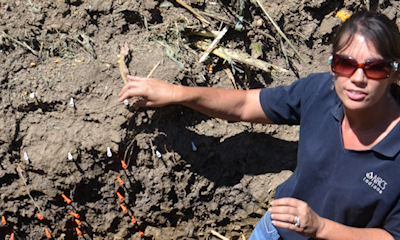
Clint Arnholt mowed down a small path of corn to dig a soils pit on his farm. Some 100 visitors were coming to Sudan Farms near Columbus to learn about soil health. He and his family have no-tilled more than 20 years, and used cover crops for nine years. He wanted to share what his soil profile looked like with others. As a matter of fact, Arnholt says he wanted to see what it looked like himself.
Related: No-till vs. bare soil and all tillage in between

Follow the dots: Dena Anderson outlined biologic channels in orange and root channels in green in this soils pit.
Dena Anderson, a soil scientist with the Natural Resources Conservation Service, took time evaluating the soils pit, dug about four feet deep on a poorly to somewhat poorly drained soil. The field is tiled, but the drainage classification refers to its natural state.
She marked earthworm or other worm channels with orange golf tees. She then marked where roots had burrowed down into the soil with green golf ties. The roots were primarily form the corn crop growing in the field.
She found evidence of root growth down several feet into the soil. In fact she found roots growing almost to the bottom of the holed. They began to stop just as they reached the underlying higher water table in the deep soil profile. Roots need to find and absorb water, but they don't like to grow in it.
Part of her message was how much biologic activity was in this soil after multiple years of cover crops growing on it each fall and winter. Biologic activity was represented by channels made by earthworms and other red-type worms.
She also pointed out the importance of having cover crops that root deep and help loosen the soil during the fall and spring months. How much they can grow and how deep they can root depends on the type of cover crop and how early they are planted in the fall, and how late they are killed in the spring.
About the Author(s)
You May Also Like




